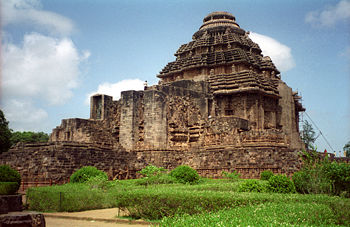Konark Travel Guide:

Introduction
Konark is a small town in Puri district in the state of Odisha, India, on the Bay of Bengal, sixty-five kilometers from Bhubaneswar. It is the site of the 13th-century Sun Temple (also known as the Black Pagoda), built in black granite by King Narasimhadeva-I (AD 1236-1264) of the Eastern Ganga Dynasty. The temple is a World Heritage Site. It takes the form of the chariot of Surya (Arka), the sun god, and is heavily decorated with stone carving. The entire complex was designed in the form of a huge chariot drawn by seven spirited horses on twelve pairs of exquisitely decorated wheels. The entrance is guarded by two lions, which are each shown crushing a war elephant. Each elephant in turn lies on top of a human body. The temple symbolises the majestic stride of the Sun god. At the entrance of the temple is a Nata Mandir. This is where the temple dancers used to perform dances in homage to the Sun god. All around the temple, there are various floral and geometric patterns. There are also human, divine and semi-divine figures in sensuous poses. The poses contains couples in various amorous poses, and are derived from the Kama Sutra. The temple is now partly in ruins, and a collection of its sculptures is housed in the Sun Temple Museum, which is run by the Archaeological Survey of India. The poet Rabindranath Tagore wrote of Konark: "Here the language of stone surpasses the language of man." Konark literally means “Essence of the Corners”.
Konark is also home to an annual dance festival, held every December, devoted to classical Indian dance forms, including the traditional classical dance of Odisha, odissi.
On 16 February 1980, Konark lay directly on the path of a total solar eclipse.
Konark beach is a popular tourist destination, though the waters are deceptively calm. Its main attraction lies in its views of the temple.
Architectural glory of the Sun Temple
He Sun Temple, built in the thirteenth century, was conceived as a gigantic chariot of the Sun God, Surya, with twelve pairs of exquisitely ornamented wheels pulled by seven horses. Majestic in conception, this temple is indeed one of the most sublime monuments of India, famous as much for its imposing dimensions and faultless proportions as for the harmonious integration of architectural grandeur with plastic allegiance. It is admittedly the best in Odisha. Its fine traceries and scrollwork, as well as the beautiful and natural cut of animal and human figures, give it a superiority over other temples.
The Sun temple belongs to the Kalinga School of Indian Temples with characteristic curvilinear towers mounted by cupolas. In shape, the temple did not make any major departure from other sikhara temples of Odisha. The main sanctum (229 ft. high) which was constructed along with the audience hall (128 ft. high) having elaborate external projections. The main sanctum which enshrined the presiding deity has fallen off. The Audience Hall survives in its entirely, but only small portions of the Dancing Hall (nata Mandir) and the Dining Hall (Bhoga-Mandap) have survived the vagaries of time. The Temple compound measures 857 ft (261 m) by 540 ft (160 m) The alignment of the Sun Temple is along the east-west direction. The Temple is located in natural surroundings, abounding with casuarina plantations and other types of trees, which grow on sandy soil. The environment is by and large unspoiled. Gentle undulating topography around the Sun Temple lends some variation to the landscape. Konark is also home to an annual dance festival, held every December, devoted to classical Indian dance forms, including the traditional classical dance of Odisha, Odissi.
Besides Konark there is also another sun temple in Odisha called Biranchi Narayan Sun Temple (Biranchi Narayan Temple) in Buguda, Ganjam District.
The stones at Konark are not joined by any limestone or cement. Instead, they are joined in a unique manner by making the two stone plates so plane like glass plate that just one drop of gum can join the two stones.
Demographics
As of 2001 India census,[1] Konark had a population of 15,015. Males constitute 52% of the population and females 48%. Konark has an average literacy rate of 57%, lower than the national average of 59.5%: male literacy is 64%, and female literacy is 49%. In Konark, 14% of the population is under 6 years of age.
Tourism
* Chandrabhaga 3.5 km From Konark Temple
* Ramachandi 8 km From Konark Temple
* Bhagabati Temple, Konark 2 km From Konark Temple
* Kuruma 6 km From Konark Temple
* Puri 35 km From Konark Temple
* Beleswar
* Chilika 70 km From Konark Temple
* Bhubaneswar
* Gopalpur Beach
* Kenduli Sasan
Lodestone
Legends describe a lodestone on the top of the Sun temple. Due to its magnetic effects, vessels passing through the Konark sea were drawn to it, resulting in heavy damage. Other legends state that magnetic effects of the lodestone disturbed ships' compasses so that they did not function correctly. To save their shipping, the Portuguese voyagers took away the lodestone, which was acting as the central stone and keeping all the stones, and the iron columns used to hold them walls together, of the temple wall in balance. Due to its displacement, the temple walls lost their balance and eventually fell down. But there is no record of this occurrence in any historical records, nor is there any record of the existence of such a powerful lodestone at Konark.
According to Legend the image of the deity or the statue of the Sun God was built of a material with iron content with 1 large magnet on top of the temple, 1 in the basement and 4 large magnets in the interiors to make the statue hang / float /suspend in air. The question remains though is how the magnets retained their effect over time as all magnetic materials loose their magnetic strength over time